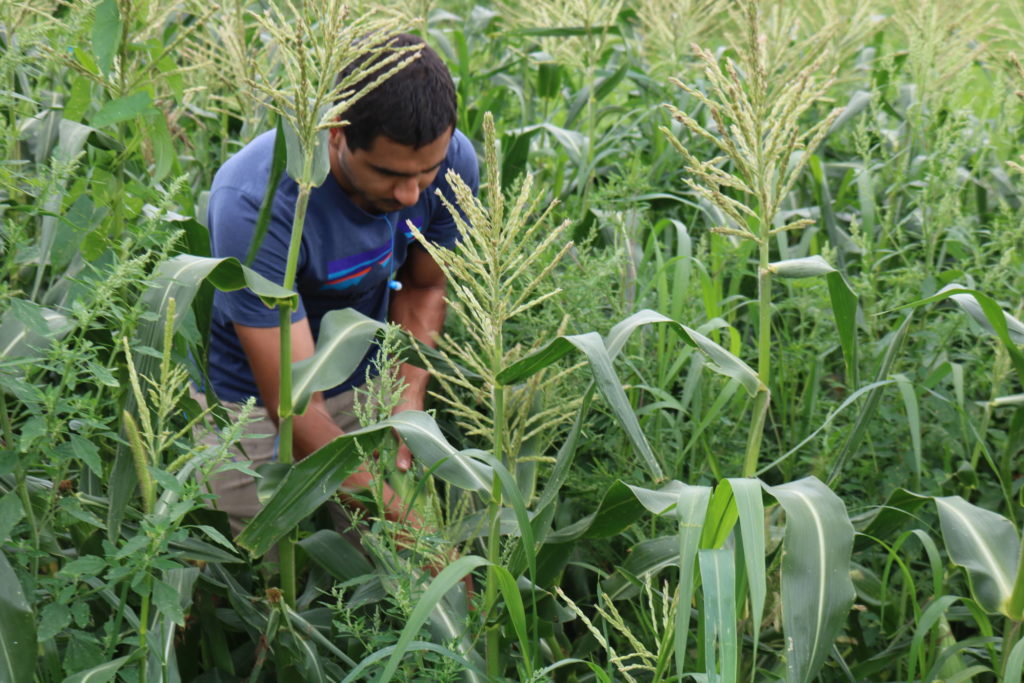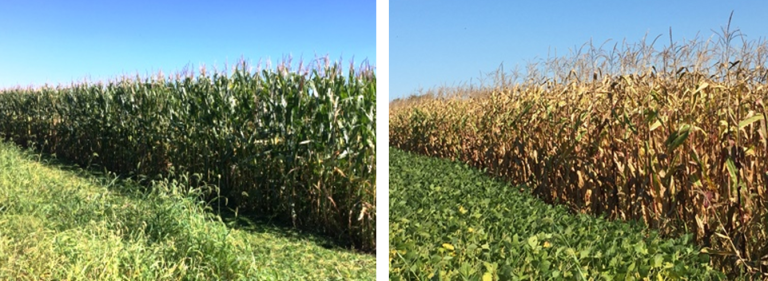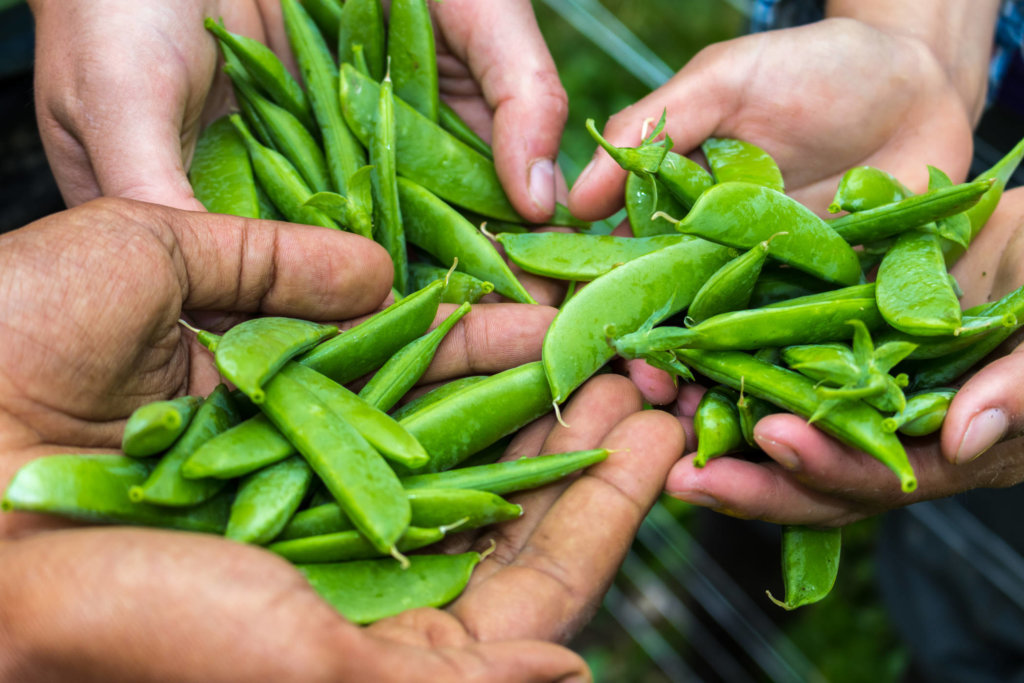This blog post is part of a special series called “The Truth About Organic.” Want more? Download the full “The Truth About Organic” guide here.
On the Rise
With the global population set to hit 9.1 billion by 20501, it’s true that in the future we’ll need to grow more food than ever. But there’s a common misconception that organic isn’t up to the task. This week, we’ll take a look at:
- why the question of yields may be the wrong question;
- why so much of the current research on organic yields is wrong;
- why more pesticides and synthetic fertilizers, no matter how precisely applied, aren’t the answer.
A Look at the Numbers
There’s an oft-cited statistic that says we’ll need to double our food production by 2050 in order to survive.2 That’s a scary number that seems to demand a production-at-all-costs approach.
But it’s important to know that the number isn’t totally accurate.
Reports that estimate we’ll need to double food production use a baseline of data from 2005—nearly 15 years ago.3 Production, both conventional and organic, has increased substantially since then. The authors of more recent research say we need to increase production by anywhere from just 20% to 70% in order to meet demand in coming years.4
“Although achieving [this] increase will be challenging,” they said, “global agricultural output is at least on the right trajectory. In contrast, agriculture’s environmental performance is going in the wrong direction: Aggregate impacts are increasing and must drop sharply over the coming decades.”5
Yes, we need to produce more food. But more importantly, we need to mitigate farming’s harmful effects on the environment—fast.
“Global agricultural output is on the right trajectory, but it’s environmental performance is going in the wrong direction.”
Agriculture accounts directly for 11-13% of greenhouse emissions and indirectly for another 12%.6 With our climate increasingly unsteady, we can’t afford to continue with current methods that erode soil and pollute the environment.
That’s why the myth that organic food can’t feed the world isn’t just wrong, it’s downright counterproductive.

Organic methods can produce competitive yields in good weather and outperform conventional in times of drought or flooding; and organic uses less energy and generates fewer emissions while revitalizing the soil and sequestering carbon. 7
If we’re going to decrease farming’s impact—and we must decrease farming’s impact—then we need organic. Because farming doesn’t only contribute to climate change; it’s greatly affected by it. And it is getting harder and harder to grow food in extreme weather.
The Problem with Yields
Conventional and organic methods are often compared based on how much crop they yield per acre or how much crop they yield per farmer.
We hear that in order to feed the world, the only solution is bigger farms with fewer farmers that achieve higher yields with new technologies like chemical fertilizers, pesticides, and GMOs—the conventional American way.
This approach leads to farm consolidation and the isolation of farm workers and rural communities—not to mention environmental degradation including soil erosion and increased air and water pollution. Agricultural pollution from conventional methods is a large contributor to the 9,000-square-mile dead zone in the Gulf of Mexico.
Is a marginal increase in yields achieved by further burdening ecosystems really worth it when other solutions exist?
Feeding the World with Organic
By abstaining from most toxic synthetic inputs, organic farmers protect the environment and prioritize soil health, wildlife habitat, clean and air water, and nutrient-dense foods. Their emphasis is typically less on maximizing crop yields and more on creating healthy, resilient ecosystems.
However, it’s untrue that the difference in yields between organic and conventional is drastic, or that organic doesn’t ever yield as much as conventional. In fact, organic outperforms conventional in adverse weather conditions like drought by as much as 40%.

As our climate grows more unsteady and generates more natural disasters, it’s imperative that our agricultural systems be not only resilient but regenerative. Only organic offers that promise.
Challenges to Current Research
Studies claiming that organic yields are unequivocally less are generally short-term, meaning they collect data over just a couple years. There is a serious dearth of long-term research on the differences between organic and conventional. Only long-term research accurately reflects changes in soil health, weather patterns and pest and disease cycles, giving a fuller picture of reality.
Our Farming Systems Trial, started in 1981, is the longest-running side-by-side trial of organic and conventional in North America. Our data shows:
- Organic yields are competitive with conventional yields after a 5-year transition period
- Organic systems produce yields up to 40% higher in drought
- Organic methods leach no toxic chemicals into waterways
- Organic uses 45% less energy
- Organic releases 40% fewer greenhouse emissions
- Organic earns 3-6x higher profits for farmers
The Farming Systems Trial is, however, limited. Our climate in Pennsylvania isn’t reflective of growing conditions the world over. That’s why we’re expanding our research and replicating the trial in new regions.
The Next Frontier: Nutrient-Density
70% of the crops grown in America are cereal grains, primarily corn and soybeans. The majority of that harvest becomes animal feed, high fructose corn syrup, and ethanol. While such large-scale grain production plays a role in the global food and biofuel supply—and isn’t going away—boosting yields of these crops isn’t going to feed the world.

To truly feed the world, we’re going to need more foods that provide complete nutrition and more farmers to grow it.
Currently, our food system overproduces grains, fats, and sugars and underproduces the vitamins, minerals, and proteins vital for human health.
We’re simply not growing enough of the right foods to meet global nutritional needs.8 At the same time, the nutrition in some fruit and vegetable crops has been declining for decades as we’ve bred for yields over flavor and health.9 Obesity, cancer, and autoimmune diseases are on the rise worldwide.
The answer to these problems isn’t maximum yields of corn and soy—it’s more nutritious food grown in a healthier way.
Untapped Potential
There is huge potential in small farmers in the developing world for increasing food production and global food security by growing diverse and nutrient-dense foods. 40% of the world’s current crop production comes from these small farmers, and they are poised to make a big difference.10
Given simple tools like viable seed and better crop varieties, these farmers can dramatically increase their productivity. Pair those tools with basic infrastructure and weather information to help time planting and harvest, and these small farmers could triple their yields.
All of these methods are organic and sustainable, and they don’t trap farmers in a cycle of binding contracts with chemical and seed companies like Bayer (Monsanto).
Instead, these practical changes can regenerate resources while dramatically increasing yields in many parts of the world.
The small-scale farmer is also nearly guaranteed to grow and raise diverse crops and livestock, enhancing biodiversity, a crucial marker of healthy ecosystems. They also are more likely to grow nutrient-dense varieties that enhance human health instead of corn or soy for animal feed.
The answer isn’t one or the other—large-scale farms or small. Demand for corn and soy will grow as more parts of the world demand animal products and biofuels integrate into more of our technology. It is possible to farm both sustainably—and we must.
I support the future of organic farming >>Waste Not
A last point to consider is that before we demand radical increases in food production, we must address food waste. More than 800 million people are hungry today despite the fact that we grow enough to provide for the current population.11 Issues including poverty, natural disaster, political unrest, and other factors prevent many from accessing healthy food.12
Additionally, one third of the food we produce globally gets lost or wasted.13 A third! What if we could recover that 33% of our global supply? Would arguments for increasing yields at the expense of the environment and human health still stand?
Most food waste happens in developed countries, where every year we waste almost as much as sub-Saharan Africa’s entire net production. While improvements in infrastructure and the supply chain are necessary, there’s still plenty we can do as individuals. Here are some ideas:
- Choose ugly produce. Large quantities of retail produce are tossed every day simply because of aesthetic irregularities and blemishes.
- Compost. Nearly a quarter (22%) of all landfill waste is organic matter14 that could be turned into healthy soil with a little time and effort. Get our backyard composting cheatsheet here.
- Grow your own. You’re less likely to toss something when you put in the effort to nurture it yourself.
- Shop and cook with the intention of using everything you buy and prepare. Split your entrée at the restaurant. Compost the leftovers.
- Join the Organic Farmers Association, an organization that advocates for better policy to assist organic farmers and change the way we think about food production across the country.
The Bottom Line
Our growing population needs farming methods that conserve and regenerate resources while generating healthy food—not methods that use more chemicals, polluting the environment in order to grow more corn to feed more feedlot animals.
The truth is that yes, organic can feed the world!
Organic can compete with conventional yields and outperform conventional in adverse weather. Small farmers using organic methods have huge potential to expand global food production. And only organic methods actively regenerate resources and protect the environment from pollution and toxic waste. For a healthy future, we can’t afford anything less.
________________________________________________________________
Here at Rodale Institute, we believe in the power of regenerative organic agriculture to heal the world.
Every day, we’re working towards solutions that make an organic future not only possible but probable.
We’re on the front lines researching nutrient-density and connections between soil health and human health to help you and your family make informed choices.
